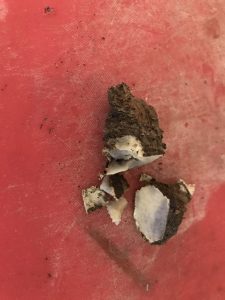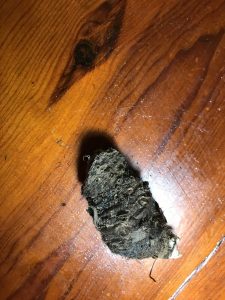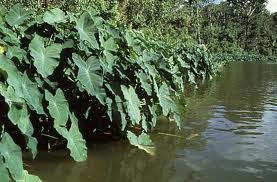IS WILD TARO IN FLORIDA EDIBLE?
Started August 2011
“Wild Taro.” My research to date:
Is the wild taro in Florida edible? In one word, no. In two… may… be….
It is doubtful the roots of the Colocasia esculenta var. aquatilis — the taro clogging Florida’s waterways — can be reasonably rid of their acid content. The young leaves, however, might be made subacid.
Background:
Edible taro has calcium oxalate that has to be eliminated by cooking before eating, either by boiling or baking or drying. There may be other chemicals at work as well under the acid umbrella which may mask what is actually happening.
Interestingly, recent academic assertions suggests the edible, cultivated taro, Colosasia esculenta is a descendant of the Colosasia aquatilis, not the other way around. If that is the case the cultivated version should more properly be named Colocasia aquatilis var. esculenta
I think the state of Florida makes an essential mistake when reporting the effects of the escaped taro on the state’s waterways. The tenor of the articles are that C. esculenta was imported and encouraged. Then it escaped and is clogging the water ways and, by the way, its roots have an acid and must be prepared correctly.
If the “wild taro” in Florida’s waterways is an escaped C. esculenta one should be able to cook it to the point of being non-acid. Cooking instructions for C. esculenta are boil roots and or leaves 45 minutes. This definitely does not work with Colocasia esculenta var. aquatilis. And that would make sense if in fact their lineage is reverse, that the cultivated less-acidic taro is a tamer version of the “wild” very acidic taro.
On two occasions I collected “wild taro” (C. aquatilis) from the St. John’s River in Sanford and the Wekiva River, at the Wekiva Marina. Boiling those chopped tiny roots for two hours in three changes of water did not eliminated the acid. Baking root chips for 30 minutes at 350F didn’t either.
Thus far I have:
1) Boiled peeled young roots size of large marbles for one hours, still acidic, which means burning the lips, tongue, mouth and inner skin of the elbow and finger webs.
2) Boiled various sizes of root sliced, none more than 1/4 thick or 3/4 inches across. Those I boiled for two hours in three changes of water at 30, 60, and 90 minutes, total actual boiling time 150 minutes (the other 30 minutes heating the water to boil again.) All parts, even small pieces, still were acidic. If it were C. esculenta the acid should have been gone by then. Thus Colocasia esculenta var. aquatilis is made of sterner stuff (said cole-oh-KAY-shah. ess-kew-LEN-tah variation a-KWA-ti-lis.)
3) I have baked peeled thin chips (like home-made potato chips, raw taro root rebels against slicing on a mandolin ) at 30 minutes at 350F, small, dark brown chip (incinerated) no immediate hint of acid. Larger tan chips at 30 minutes at 350F produce, after chewing, a hint of nasturtium odor and tingle to the nose and then mouth burn within half a minute. A mouth rinse with lemon juice put the fire out but my mouth was mildly sore for several hours.
4) Chips baked for an hour at 350F became cinders. I have not tried a slow, low roast for several hours. A tiny root baked unpeeled for three hours at 350 had no immediate burn on inner elbow skin. It was too unappealing for a mouth test. So much for the roots.
Another next step is to roast large roots on moderate heat for two hours then grate them. Then soak them for a full day changing the water often. We’ll see how that works. It is similar to what the aborigines do in Australia with a yam that has calcium oxalates in it, except they stick the roasted, grated yam in a river for a day to leach.
5) Young leaves (under six inches inner clef to tip) boiled one hour with a change of water at 30 minutes, still acidic. Boiled for two hours in three changes of water no apparent acid, but petiole (stem) near blade (leaf) was still acidic. Repeated minus stem: Boiled two hours, water changes at 30, 60 and 90 minutes, total boiling time 150 minutes (30 to heat water after two changes.) Young leaves treated that way appear to lose their contact acid. Taste mild, if not pleasant, no oral burn. Did not consume. Edibility of the leaves of Florida’s version is unknown. Even if long-boiled leaves are edible the energy expenditure for the energy/nutritional value gained would be quite negative.

Cooked Colocasia esculenta var. aquatilis photo by Green DSeane

Uncooked Colocasia esculenta var. aquatilis. Photo by Green Deane
6)I dug up a small corm, April 2022. It was peppery raw. After roasting an hour at 350F it was soft and flavoful but still peppery.Perhaps what natives did with other plants with calcium oxalates is bury it and build a fire over it for several days.
7) Another possibility is to try drying the leaves, and or leaves and petioles separated. See below.
8) Internet searching produced a Japanese monograph (1) in 2002 about C. aquatilis in northern Vietnam. In the abstract it states: The uses and habitats of C. esculenta var. aquatilis were linked to the agroecosystems of the delta. The plant was frequently found around canals and farmers’ ponds in the delta, and its petioles and stolons were harvested for human consumption and pig fodder.
Petioles and stolens, read stems and spaghetti-like rootlets. This might be worth more investigation, and it would have been nice if methods of collection, preparation and cooking were included. I did not cook any stolons, using corms only, and I tried the top of only one young petiole.
First, the stolons are hard to clean, or at least the ones found in the Wekiva are, mucky like cattail roots. Next, of course, is the conflict between their report and my own experiment. I found long-boiled boiled leaves non-acidic and the stem (petiol) acidic. They make no mention of leaves and say the stems are edible. Of course the state of acid and edibility are two different issues, perhaps related but not necessarily so. Even if the Florida version could be rendered acid-less that is no indication of edibility just absence of acid.
(1) Tropical agriculture: Japanese journal of tropical agriculture Japanese journal of tropical agriculture: Vol.46, No.4(20021201) pp. 247-258 Vol.46, No.4 (20021201) pp. 247-258: 日本熱帯農業学会 ISSN:00215260 Japan Society for Tropical Agriculture ISSN: 00215260



I`ve been using cultivated taro tuber for many years, after learning that they cured my heartburn better than any medication. Now to connect your concerns about wild taro invading floridian wetlands with my project “Bionic Control of Invasive Plant Species”; which is to promote their consumption before anyone sprays them with herbicides. If Aquatic Taro appears to be inedible, maybe it could be harvested to produce some kind of antacid medicine by processing the tubers, to seperate the poisoness from the healing components, on an industrial level by pharmaceutical companies, so any heartburn victim would help preserve native plant societies ?
Not a bad idea except the plants tends to not put on any substantial roots, just stringy stolons. A root the size of your big finger is large for this aquatic species.
How about crossbreeding ? To pollinate Aquatic taro with culivated Taro so maybe in the future all wild taro would develope tuberous roots and become edible, so human consumption could promote nature conservation ?
what about a pressure cooker?
I don’t know, but I would think not because dry heat breaks down the chemical better than moist heat.
Have you tried steeping the tubers in cold water overnight? It is supposed to reduce the acid in edible taro.
Not, but the tubers are so small in that particular variety there’s little left after peeling.
The wild taro is not edible at all and actually highly toxic to humans first side affects are painful and irritable tingles and swelling in the mouth and lips it can also cause side affects like stomach guastation.
Raw perhaps so, cooked or properly prepared that might be different. But I generally agree one should stay away from it.
In Trinidad and Tobago WI, this plant can be found in some water ways. It seems to have been brought down stream by the rivers which suggest that it either was planted as food for enslaved Africans high in the foothills. It tastes like the commercially grown Dasheen/ Taro but irritates the mouth. I suspect that it is grown by adventitious shoots which is unlike taro that usually has suckers attached to the parent plant.
Would cooking the leaves with baking soda neutralize the acidity in the leaves?
Theres a frozen yogurt place called “Mochi” that carries a taro flavor. Easily the best flavor.
The Taro flavor of mochi is from the cultivated variety.
It could take up to 5 hour of boiling to be edible.. you can tell when the skin can peel off easy with a pinch of the fingers.. I’ve been looking for this taro anywhere I can find the close to ft lauderdale?
I’m not sure if this would work on wild taro, but in Turkey several species of Arum are eaten after a special treatment in which they chop the leaves and leave them to ferment in water mixed with some flour. They seal the lid on with flour paste and leave it for about two days before boiling it for quite a long time. The result is a tart almost lemony flavor but no burning.
Hey Deane,
I recently acquired a taro plant at plant swap and I’m wondering if there is any identifiable way to differentiate between the cultivar and the wild variation? Do you have any experience or suggestions for this?
Pls leave elephant ears alone they’re highly toxic
While camping and hiking in Chiapas, Mexico I found many of this inedible species of taro. I was about to harvest one when I remembered that a friend had told me how to distinguish the edible variety from the inedible one. Therefore I carefully dug out a small piece of the root and found it to be different in appearance. Nonetheless, I touched it to my tongue. For the next 90 minutes I experienced a very irritating burning sensation on my lips and tongue.
I love the fact that you did so much research! This is a very helpful article. Thank you for going to so much effort!
In India we soak them into a bowl of dilute tamarind extract or buttermilk and keep them aside for at least half an hour or cook them with turmeric and salt, discard the water. It might be worth a try for the brave at heart.
I had a run-in with wild taro in Puerto Rico and it was not fun. Someone mentioned that they do eat it here, but you have to cut out the eyelets and peel and leave it in the sun for a certain amount of time. Apparently some people still use them in the outer dough (masa) of pasteles (like a local tamale boiled in banana leaf)
I am grateful to you for having done so much research on these plants and their culinary uses. In no case of your attempts at boiling out the oxalic acid did you cook it for the minimum duration of time recommended by native Hawaiians, which is at least 4 hours, and as much as 6, at full steam. Also, the taro leaves are wrapped in t’i leaves for the steaming/cooking process. I wouldn’t be surprised to learn that the t’i leaf conveys some neutralizing compounds to the equation. Perhaps if you were to try it again after this treatment, you would find it more edible? And yes, the water in the steamer is quite a dark tea at the end of this process. I have to replace the water at least once, as it boils completely away otherwise. Four hours is a long time. As for nutritional value, the minerals in taro leaf are on par with spinach. And it’s delicious, IMHO.
We went out this morning and cut a hundred or so luau/taro leaves on the St John’s river Palatka Fl. In Hawaii the whole plant is consumed and like most other food if it’s cooked good it is good!
Did you eat it?
I came here looking for art references and instead fell head over heels into your whole process of cooking and eating this taro. The fact that you went through so much just to let people know that maybe this isn’t edible is so courageous and yet so funny. Thank you
Adding more information this weeek.
A joy to read. Thank you.